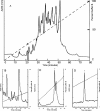Biochemical characterization of kappaM-RIIIJ, a Kv1.2 channel blocker: evaluation of cardioprotective effects of kappaM-conotoxins
- PMID: 20220134
- PMCID: PMC2865319
- DOI: 10.1074/jbc.M109.068486
Biochemical characterization of kappaM-RIIIJ, a Kv1.2 channel blocker: evaluation of cardioprotective effects of kappaM-conotoxins
Abstract
Conus snail (Conus) venoms are a valuable source of pharmacologically active compounds; some of the peptide toxin families from the snail venoms are known to interact with potassium channels. We report the purification, synthesis, and characterization of kappaM-conotoxin RIIIJ from the venom of a fish-hunting species, Conus radiatus. This conopeptide, like a previously characterized peptide in the same family, kappaM-RIIIK, inhibits the homotetrameric human Kv1.2 channels. When tested in Xenopus oocytes, kappaM-RIIIJ has an order of magnitude higher affinity (IC(50) = 33 nm) to Kv1.2 than kappaM-RIIIK (IC(50) = 352 nm). Chimeras of RIIIK and RIIIJ tested on the human Kv1.2 channels revealed that Lys-9 from kappaM-RIIIJ is a determinant of its higher potency against hKv1.2. However, when compared in a model of ischemia/reperfusion, kappaM-RIIIK (100 mug/kg of body weight), administered just before reperfusion, significantly reduces the infarct size in rat hearts in vivo without influencing hemodynamics, providing a potential compound for cardioprotective therapeutics. In contrast, kappaM-RIIIJ does not exert any detectable cardioprotective effect. kappaM-RIIIJ shows more potency for Kv1.2-Kv1.5 and Kv1.2-Kv1.6 heterodimers than kappaM-RIIIK, whereas the affinity of kappaM-RIIIK to Kv1.2-Kv1.7 heterodimeric channels is higher (IC(50) = 680 nm) than that of kappaM-RIIIJ (IC(50) = 3.15 mum). Thus, the cardioprotection seems to correlate to antagonism to heteromultimeric channels, involving the Kv1.2 alpha-subunit rather than antagonism to Kv1.2 homotetramers. Furthermore, kappaM-RIIIK and kappaM-RIIIJ provide a valuable set of probes for understanding the underlying mechanism of cardioprotection.
Figures







References
-
- Coetzee W. A., Amarillo Y., Chiu J., Chow A., Lau D., McCormack T., Moreno H., Nadal M. S., Ozaita A., Pountney D., Saganich M., Vega-Saenz de Miera E., Rudy B. (1999) Ann. N.Y. Acad. Sci. 868, 233–285 - PubMed
-
- Jan L. Y., Jan Y. N. (1997) Annu. Rev. Neurosci. 20, 91–123 - PubMed
-
- Gulbis J. M. (2002) Novartis Found. Symp. 245, 127–141 - PubMed
-
- Röckel D., Korn W., Kohn A. J. (1995) Manual of the Living Conidae, Verlag Christa Hemmen, Wiesbaden, Germany
-
- Olivera B. M. (2006) J. Biol. Chem. 281, 31173–31177 - PubMed
Publication types
MeSH terms
Substances
Grants and funding
LinkOut - more resources
Full Text Sources
Other Literature Sources
Molecular Biology Databases
Research Materials

